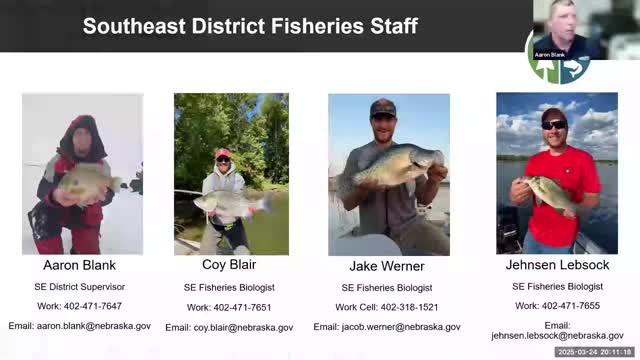Fishery Managers Assess Regulations for Lake Wanahoo Amid Species Concerns
January 01, 2025 | Nebraska Game and Parks Commission (NGPC), State Agencies, Organizations, Executive, Nebraska
This article was created by AI summarizing key points discussed. AI makes mistakes, so for full details and context, please refer to the video of the full meeting. Please report any errors so we can fix them. Report an error »

The Nebraska Southeast District Fisheries Meeting held on January 1, 2025, brought important discussions regarding the management of local water bodies and the impact of invasive species on fisheries. A key focus was the regulation surrounding live bait usage in certain lakes, particularly Lake Wanahoo, which has faced challenges from problematic species like common carp and gizzard shad.
Officials emphasized the delicate balance in managing these regulations. They noted that maintaining restrictions on live bait can help control the population of invasive species, which, if left unchecked, can lead to significant declines in fish populations. The discussion highlighted the importance of consistency in regulations to avoid confusing anglers, especially when considering potential future renovations of lakes that may be necessary to restore fish habitats.
Lake Wanahoo was specifically mentioned as a case study. The lake has seen the introduction of gizzard shad, prompting a reevaluation of its management strategy. While the presence of invasive species is concerning, officials indicated that the situation is not entirely bleak, suggesting that there are still opportunities for positive outcomes in fishery management.
In addition to Lake Wanahoo, the meeting included discussions on ongoing evaluations of other water bodies and the overall health of sport fisheries in the region. The Nebraska Game and Parks Commission (NGPC) remains committed to monitoring these ecosystems closely to ensure sustainable fishing practices and protect local aquatic life.
As the meeting concluded, officials reiterated their dedication to adapting management strategies based on the evolving conditions of Nebraska's lakes, aiming to foster a thriving environment for both fish populations and the anglers who enjoy them. The outcomes of these discussions will play a crucial role in shaping the future of fisheries in the Southeast District, directly impacting the community's recreational opportunities and ecological health.
Officials emphasized the delicate balance in managing these regulations. They noted that maintaining restrictions on live bait can help control the population of invasive species, which, if left unchecked, can lead to significant declines in fish populations. The discussion highlighted the importance of consistency in regulations to avoid confusing anglers, especially when considering potential future renovations of lakes that may be necessary to restore fish habitats.
Lake Wanahoo was specifically mentioned as a case study. The lake has seen the introduction of gizzard shad, prompting a reevaluation of its management strategy. While the presence of invasive species is concerning, officials indicated that the situation is not entirely bleak, suggesting that there are still opportunities for positive outcomes in fishery management.
In addition to Lake Wanahoo, the meeting included discussions on ongoing evaluations of other water bodies and the overall health of sport fisheries in the region. The Nebraska Game and Parks Commission (NGPC) remains committed to monitoring these ecosystems closely to ensure sustainable fishing practices and protect local aquatic life.
As the meeting concluded, officials reiterated their dedication to adapting management strategies based on the evolving conditions of Nebraska's lakes, aiming to foster a thriving environment for both fish populations and the anglers who enjoy them. The outcomes of these discussions will play a crucial role in shaping the future of fisheries in the Southeast District, directly impacting the community's recreational opportunities and ecological health.
View full meeting
This article is based on a recent meeting—watch the full video and explore the complete transcript for deeper insights into the discussion.
View full meeting
